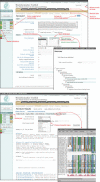The MPI Bioinformatics Toolkit for protein sequence analysis
- PMID: 16845021
- PMCID: PMC1538786
- DOI: 10.1093/nar/gkl217
The MPI Bioinformatics Toolkit for protein sequence analysis
Abstract
The MPI Bioinformatics Toolkit is an interactive web service which offers access to a great variety of public and in-house bioinformatics tools. They are grouped into different sections that support sequence searches, multiple alignment, secondary and tertiary structure prediction and classification. Several public tools are offered in customized versions that extend their functionality. For example, PSI-BLAST can be run against regularly updated standard databases, customized user databases or selectable sets of genomes. Another tool, Quick2D, integrates the results of various secondary structure, transmembrane and disorder prediction programs into one view. The Toolkit provides a friendly and intuitive user interface with an online help facility. As a key feature, various tools are interconnected so that the results of one tool can be forwarded to other tools. One could run PSI-BLAST, parse out a multiple alignment of selected hits and send the results to a cluster analysis tool. The Toolkit framework and the tools developed in-house will be packaged and freely available under the GNU Lesser General Public Licence (LGPL). The Toolkit can be accessed at http://toolkit.tuebingen.mpg.de.
Figures
References
-
- Subramaniam S. The biology workbench—a seamless database and analysis environment for the biologist. Proteins. 1998;32:1–2. - PubMed
Publication types
MeSH terms
Substances
LinkOut - more resources
Full Text Sources
Other Literature Sources
Research Materials


